Siege of Ciudad Rodrigo
Part II
January 1812
The Assault
Commentary by John Salmon, translations by Jane Hoyle
| |
General Viscount Wellington KB to the Earl of Liverpool, Secretary of State Gallegos, 15th January 1812 My Lord We have continued our operations against Ciudad Rodrigo since I addressed you on the 9th instant. We opened our fire from 22 pieces of ordnance, in three batteries in the first parallel, yesterday afternoon; and we opened an approach to, and established ourselves in, our second parallel, 150 yards from the place, last night. This measure had been facilitated by Lieut General Graham, having surprised the enemy's detachment in the convent of Santa Cruz close to the body of the place, on the night of the 13th. The right of our approaches was protected and secured by this operation. Major General the Hon C Colville who commands the 4th division in the absence of Lieut General the Hon G L Cole, likewise attacked the enemy's post in the convent of San Francisco last night, and obtained possession of that post, and of the other fortified posts in the suburbs, where our troops are now lodged. Our left is protected and secured by this operation. Two pieces of cannon were taken in the convent of San Francisco. It appears that the preparations and movements which I first made with a view to the attack of Ciudad Rodrigo had the effect of inducing the enemy to move back from La Mancha. The divisions of the army of Portugal, two of which had gone as far as Cuenca, and the other to San Clemente, returned to Toledo in the beginning of this month; and they are now on their march, it is stated, towards Valladolid, to which place Marshal Marmont went on the 5th from Talavera. One division of infantry still remained on the 12th instant at Navalmoral, having detachments as far back as Talavera; and it is reported that a second division remained about Talavera. It appears that the governments of Valladolid and Salamanca, called the 6th and 7th governments, have been placed under the directions of Marshal Marmont, and that what can be plundered from those provinces is allotted for the support of the troops under his command; and the army of the North are to be confined to the northern provinces. Preparations to a certain extent are making at Salamanca for the movement of troops in this direction; [sic] and I have reports that troops were to be collected at Salamanca on this day. It appears, however, that the enemy did not even know at Salamanca that we had attacked Ciudad Rodrigo till the 13th, and it is not probable that a sufficient force can be collected to oblige us to raise the siege, at least for some days. I propose, therefore, to continue the siege as long as I shall think there is any prospect of success, and till I shall be certain that the enemy have brought together such a force as to render success hopeless, and the situation of the army critical. We have had, till now, very fine weather, and the troops have suffered but little from exposure to it. I enclose the returns of the casualties to the 14th instant. It is impossible for me, even now, to tell how much longer the operations will last. No time has been lost yet; and your Lordship may be certain that every exertion will be made to bring them to a successful termination. I have received no authentic accounts of the state of affairs in Valencia; but I have reason to believe that, as late as the 24th December, the enemy had not been able to make any progress in their attack upon that place. It is supposed that, unless powerfully supported, Marshal Suchet must retire. By the accounts from Cadiz to the 29th December, it appears to be supposed that the French had not been able to get their guns up to Tarifa, having been prevented by the bad weather which continued to prevail generally throughout the Peninsula till the 5th and 6th of this month. By accounts from Lieut General Hill to the 11th instant, it appears that General Drouet had been reinforced from Seville, and had advanced again towards Zafra. I think it probable that General Hill will have moved on the 12th or 13th towards the frontiers of Portugal, according to the orders which I informed your Lordship, in my dispatch of the 9th instant, I had sent him. I have the honour to be &c News of the siege may have filtered through, or it could be that Wellington's informants are mistaking the supply convoy, mentioned in Marmont's letter to Berthier of January 13th, for a relief column. In either case the danger to Ciudad Rodrigo is starting to attract forces back to the Ciudad Rodrigo area from reinforcing Suchet, which was one of Wellington's main aims.
Unfortunately, as we have already said, even without their help, Valencia will fall. Wellington is obviously aware, however, that time is getting short if he is to take the fortress before French forces arise to interfere with his plans. The breaches so far battered in Ciudad Rodrigo's walls are not yet practicable according to the general practice of siege craft. Nevertheless, Wellington determines that on the night of the 19th January they will be assaulted. On the 20th, he writes once more to Lord Liverpool. General Viscount Wellington KB to the Earl of Liverpool, Secretary of State Gallegos, 20th January 1812 My Lord I informed your Lordship in my dispatch of the 9th that I had attacked Ciudad Rodrigo, and in that of the 15th, of the progress of the operations to that period, and I have now the pleasure to acquaint your Lordship that we took the place by storm yesterday evening after dark. We continued from the 15th to the 19th to complete the second parallel, and the communications with that work, and we had made some progress by sap towards the crest of the glacis. On the night of the 15th, we likewise advanced from the left of the first parallel down the slope of the hill towards the convent of San Francisco to a situation from which the walls of the fausse braie and of the town were seen, on which a battery for seven guns was constructed, and these commenced their fire on the morning of the 18th. In the meantime, the batteries in the first parallel continued their fire; and, yesterday evening, their fire had not only considerably injured the defence of the place, but had made breaches in the fausse braie wall, and in the body of the place, which were considered practicable; while the battery on the slope of the hill, which had been commenced on the night of the 15th, and had opened on the 18th, had been equally efficient still farther to the left, and opposite to the suburb of San Francisco. I therefore determined to storm the place, notwithstanding that the approaches had not been brought to the crest of the glacis, and the counterscarp of the ditch was still entire. The attack was accordingly made yesterday evening, in five separate columns, consisting of the troops of the 3rd and Light divisions, and of Brigadier General Pack's brigade.
The two right columns conducted by Lieut Colonel O'Toole of the 2nd Cacadores, and Major Ridge of the 5th Regiment, were destined to protect the advance of Major General Mackinnon's brigade, forming the 3rd, to the top of the breach in the fausse braie wall; and all these, being composed of the troops of the 3rd Division, under the direction of Lieut General Picton. The fourth column, consisting of the 43rd and 52nd regiments, and part of the 95th Regiment, being of the Light Division, under the direction of Major General Craufurd, attacked the breaches on the left in front of the suburb of San Francisco, and covered the left of the attack of the principal breach by the troops of the 3 rd Division; and Brigadier General Pack was destined, with his brigade, forming the fifth column, to make a false attack upon the southern face of the fort. Besides these five columns, the 94th Regiment, belonging to the 3rd division, descended into the ditch in two columns, on the right of Major General Mackinnon's brigade, with a view to protect the descent of that body into the ditch and its attack of the breach in the fausse braie, against the obstacles which it was supposed the enemy would construct to oppose their progress. All these attacks succeeded; and Brig General Pack even surpassed my expectations, having converted his false attack into a real one; and his advanced guard, under the command of Major Lynch, having followed the enemy's troops from the advanced works into the fausse braie, where they made prisoners all opposed to them. Major Ridge of the 2nd battalion of the 5th Regiment, having escaladed the fausse braie wall, stormed the principal breach in the body of the place, together with the 94th Regiment, commanded by Lieut Colonel Campbell, which had moved along the ditch at the same time, and had stormed the breach in the fausse braie, both in front of Major General Mackinnon's brigade. Thus, these regiments not only effectually covered the advance from the trenches of Major General Mackinnon's brigade by their first movements and operations, but they preceded them in the attack. Major General Craufurd and Major General Vandeleur, and the troops of the Light Division on the left, were likewise very forward on that side; and, in less than half an hour from the time the attack commenced, our troops were in possession of, and formed on the ramparts of the place, each body contiguous to the other. The enemy then submitted, having sustained a considerable loss in the contest. Our loss was also, I am concerned to add, severe, particularly in officers of high rank and estimation in this army. Major General Mackinnon was unfortunately blown up by the accidental explosion of one of the enemy's expense magazines, close to the breach, after he had gallantly and successfully led the troops under his command to the attack. Major General Craufurd likewise received a severe wound while he was leading on the Light Division to the storm, and I am apprehensive that I shall be deprived for some time of his assistance. Major General Vandeleur was likewise wounded in the same manner, but not so severely, and he was able to continue in the field. I have to add to this list Lieut Colonel Colborne of the 52nd Regiment, and Major George Napier, who led the storming party of the Light Division, and was wounded on the top of the breach. I have great pleasure in reporting to your Lordship the uniform good conduct, and spirit of enterprise, and patience, and perseverance in the performance of great labour, by which the General Officers, officers and troops of the 1st 3rd , 4th and Light Divisions, and Brig General Pack's brigade, by whom the siege was carried on, have been distinguished during the late operations. Lieut General Graham assisted me in superintending the conduct of the details of the siege, besides performing the duties of the General Officer commanding the 1st Division; and I am much indebted to the suggestions and assistance I received from him for the success of this enterprise. The conduct in all parts of the 3rd Division in the operations which they performed with so much gallantry and exactness on the evening of the 19th in the dark, afford the strongest proof of the abilities of Lieut General Picton and Major General Mackinnon, by whom they were directed and led; but I beg particularly to draw your lordship's attention to the conduct of Lieut Colonel O'Toole of the 2nd Cacadores, of Major Ridge of the 2nd Battalion, 5th Foot, of Lieut Colonel Campbell of the 94th Regiment, of Major Manners of the 74th, and of Major Grey of the 2nd Battalion, 5th Foot, who has been twice wounded during this siege. It is but justice also to the 3 rd Division to report that the men who performed the sap belonged to the 45th, 74th and 88th Regiments, under the command of Captain Macleod of the Royal Engineers, and Captain Thompson of the 74th, Lieut Beresford of the 88th, and Lieut Metcalf of the 45th, and they distinguished themselves not less in the storm of the place than they had in the performance of their laborious duty during the siege. I have already reported in my letter of the 9th instant, my sense of the conduct of Major General Craufurd, and of Lieut Colonel Colborne, and of the troops of the Light Division, in the storm of the redoubt of San Francisco, on the evening of the 8th instant. The conduct of these troops was equally distinguished throughout the siege; and in the storm, nothing could exceed the gallantry with which these brave officers and troops advanced and accomplished the difficult operation allotted to them, notwithstanding that all their leaders had fallen. I particularly request your Lordship's attention to the conduct of Major General Craufurd, Major General Vandeleur, Lieut Colonel Barnard of the 95th, Lieut Colonel Colborne, Major Gibbs and Major Napier of the 52nd, and Lieut Colonel Macleod of the 43rd. The conduct of Captain Duffy of the 43rd, and that of Lieut Gurwood of the 52nd Regiment, who was wounded, have likewise been particularly reported to me. Lieut Colonel Elder and the 3rd Cacadores were likewise distinguished upon this occasion. The 1st Portuguese regiment, under Lieut Colonel Hill, and the 16th, under Colonel Campbell, being Brig General Pack's brigade, were likewise distinguished in the storm, under the command of the Brigadier General, who particularly mentions Major Lynch. In my dispatch of the 15th, I reported to your Lordship the attack of the convent of Santa Cruz by the troops of the 1st Division, under the direction of Lieut General Graham, and that of the convent of San Francisco on the 14th instant, under the direction of Major General the Hon C Colville. The first mentioned enterprise was performed by Captain Laroche de Starkerfels, of the 1st Line Battalion, King's German Legion, the last by Lieut Colonel Harcourt, with the 40th Regiment. This regiment remained from that time in the suburb of San Francisco, and materially assisted our attack on that side of the place. Although it did not fall to the lot of the troops of the 1st and 4th divisions to bring these operations to a successful close, they distinguished themselves throughout their progress by the patience and perseverance with which they performed the labour of the siege. The Brigade of Guards, under Major General H Campbell, were particularly distinguished in this respect. I likewise request your Lordship's attention to the conduct of Lieut Colonel Fletcher, the Chief Engineer, and of Brigade Major Jones, and the officers and men of the Royal Engineers. The ability with which these operations were carried on exceeds all praise; and I beg leave to recommend these officers to your Lordship most particularly. Major Dickson of the Royal Artillery, attached to the Portuguese artillery, has for some time had the direction of the heavy train attached to this army, and has conducted the intricate details of the late operation, as he did that of the two sieges of Badajoz in the last summer, much to my satisfaction. The rapid execution produced by the well directed fire kept up from our batteries affords the best proof of the merits of the officers and men of the Royal artillery, and of the Portuguese artillery, employed on this occasion; but I must particularly mention Brigade Major May, and Captains Holcombe, Power, Dynely and Dundas of the Royal Artillery, and Captains De Cunha and Da Costa, and Lieut Silva, of the 1st Regiment of Portuguese artillery. The Adjutant General, and the Deputy Quarter Master General, and the officers of the several departments, gave me every assistance throughout this service, as well as those of my personal staff; and I have great pleasure in adding that, notwithstanding the season of the year, and the increased difficulties of procuring supplies for the troops, the whole army have been well supplied, and every branch of the service provided for during the late operations, by the indefatigable exertions of Mr Commissary General Bissett, and the officers belonging to his department. The Mariscal de Campo, Don Carlos de España, and Don Julian Sanchez, observed the enemy's movements beyond the Tormes during the operations of the siege; and I am much obliged to them, and to the people of Castille in general, for the assistance I received from them. The latter have invariably shown their detestation of the French tyranny, and their desire to contribute, by every means in their power, to remove it. I shall hereafter transmit to your Lordship a detailed account of what we have found in the place; but I believe that there are 153 pieces of ordnance, including the heavy train belonging to the French army, and great quantities of ammunition and stores. We have the Governor, General Barrié, about 78 officers, and 1700 men, prisoners. I transmit this dispatch by my aide de camp, Major the Hon A Gordon, who will give your Lordship any further details you may require; and I beg leave to recommend him to your protection. I have the honour to be, &c Digest of Casualty List
Wounded 818 Missing 7 Siege OverThe siege was over and the fortress in Wellington's hands. The cost had been high, among the many wounded including Major General Craufurd, who died later. He was buried within the walls of the fortress. Once the city had been captured the troops ran amok. Some buildings were set on fire, many soldiers got drunk and they plundered the homes of their erstwhile allies the Spanish. Order was soon restored, however, but these events were repeated on a larger scale when Badajoz was taken on 6 April 1812. What of poor General Barrié, reluctant governor of Ciudad Rodrigo, now a prisoner for whom no-one on the French side has a good word to say. He wrote the following letter to the Minister for War while a prisoner of war, on 8th August 1812. By this time Napoleon has more to worry about than what took place at the beginning of the year. He was fighting in Russia, storming Smolensk (17th August). Barrié's letter is interesting on many levels but chiefly because it gives an account of the siege from inside the city. Report on the Defence of Ciudad Rodrigo by General Barrié to the Minister for War When the enemy presented itself before the city walls, the Ciudad Rodrigo garrison believed that it had just enough food to survive an attack, although there was only enough bread to last until 2nd February, and meat had been short for some time. But the governor, with great foresight, had made several sorties from the city, and had managed to procure a hundred pigs which meant that pig meat could be distributed one day and vegetables the next. Prior to investment, the enemy had made no movement that would have given rise for alarm. He limited himself to occupying villages and hamlets in the district, and making frequent patrols with a view to intercepting our communications with Salamanca. Some of the deserters, who came over to us made contradictory statements about the movement of the various English corps, but they all said categorically that the English army was very short of provisions, and that several divisions were obliged to cross the Coa to obtain subsistence. I was pretty certain that lord Wellington had brought up a large quantity of heavy artillery to Almeida and that he must have been very annoyed at having let slip the little convoy that escorted me into Ciudad Rodrigo. And I felt sure that he would make every effort to capture the city. During early December, the enemy busied himself building bridges over the Agueda and one of these was solid enough to carry their heavy artillery across the river. This bridge was between Gallegos and San Felices, two leagues from the city. At the same time, they commandeered all the local carts and oxen to transport their projectiles and provisions to support the army while it was stationed on the right bank of the Agueda. I gave details of all these movements to my Commander-in-Chief, Count Dorsenne, in my letters of 8th and 30th December, sending them through General Thiébalt, governor of the Salamanca garrison. While we were awaiting military assistance on the 8th January, we noticed that the English army was moving to the Convent of La Caridad to the south of the city. Many columns took up their position on the Salamanca road, and others set themselves up in gullies to the north of the city. At about 3 o'clock, one of our reconnaissance patrols reported that they had seen many vehicles unloading gabions and fascines. I had no doubt that we were about to be attacked so I strengthened the guard on the Renaud Redoubt, adding 50 more infantrymen commanded by an officer and eight gunners commanded by another officer to the 10 infantrymen and five gunners already there. The artillery officer took enough ammunition with him for three pieces already there and had a conference with the engineer officer to discuss further means of defence. Ammunition for the two pieces was placed in the San Francisco convent whose personnel were ordered to monitor the movements of the enemy, and to back up colleagues in the Renaud Redoubt should it prove necessary. These dispositions were barely set up when between seven and eight o'clock in the evening, a lively fusillade made it clear to us that the redoubt was under attack. Under heavy cannon fire we managed to throw a few grenades at the enemy, but soon after, we heard a "hurrah!" which continued until the firing ceased and it became clear that the redoubt had been captured. Having seen what was going on at this time, all the guns from the city started firing and this went on all night. At daybreak, we were able to see that the Greater Teson was covered with English troops. A parallel led to the Renaud Redoubt as well as a communication trench. We hurled many bombs at the enemy, and the battery in the San Francisco convent made life uncomfortable for the enemy soldiers working in the trenches. I issued an order to the inhabitants that any-one wanting to leave the city at this time should do so right away. And from that moment, all communication with the outside world ceased. I sent two emissaries to Salamanca during the night of the 9-10th, who were instructed to convey the news to General Thiébalt that we had lost the Renaud Redoubt. Our artillery continued firing on ground occupied by the enemy and threw fireballs which lit up some of the trenches they were digging. The San Francisco fortification fired all night and made several sorties from the post, and those in the convent of Santa Cruz also managed to make life difficult for the enemy who meanwhile extended his parallel towards the right, following the slope of the terrain, within the line of fire of two of our big batteries. At daylight we noticed that many sacks of earth had been brought up; the magazines for the enemy batteries were full of them, as well as the parallel and communication trench. Many of the workers fired from within and outside the batteries and formed an artillery park behind the redoubt. We directed our fire on those places where the work seemed less effective, and the mortars hurled bombs on batteries which had already been established. Thirty guns from the ramparts of the city fired on any of the workers who came within our line of fire.
During the night of 10/11th January, yet another message was sent to Salamanca to keep them abreast with events. The enemy formed a hook to the right of the parallel and another to the left to counter any attacks made by the San Francisco convent fortification. They even placed marksmen in the foxholes which had been dug nearby. Local wagons could be seen in the batteries and near the trenches. We continued firing at the enemy and the San Francisco post managed to dislodge the enemy marksmen from their foxholes nearby. During the night of the 11/12th, the enemy opened up via a zigzag at the end of the first parallel, enabling him to advance towards the town. He did this through a flying sap, using sacks of earth. At daybreak the work did not seem to be satisfactory so he continued it during the day. He also continued work on the batteries. We brought all our mortars into play and kept up the fire as on preceding days. One of the two pieces in the San Francisco Convent was put out of action and was replaced by a small howitzer which was placed at the foot of the terrace. The enemy did not advance very far but he worked hard on his batteries, preparing platforms for them, and he finished the zigzag in front of the first parallel. Our artillery kept on firing throughout the night and musket fire from the San Francisco and Santa Cruz convents were directed at the enemy's works. On the 13th, at about 8 o'clock in the evening, the Santa Cruz convent was attacked by forces superior in number to ours. The fifty men there were obliged to retire with some loss, throwing themselves into the trenches nearby. The enemy then constructed two long zigzags which led to the foot of the Lesser Teson. On the morning of the 14th, we made a sortie from the town and managed to destroy these works. We recaptured the convent of Santa Cruz, and did not return to the town until enemy reserves arrived. We left a command post in the convent. At about 3 o'clock in the afternoon, the English exposed their embrasures and began firing with 24 pieces from the two big batteries. Firing ceased by nightfall and we returned to the post of the Santa Cruz Convent. During the night of the 14/15th, the San Francisco convent and suburb were attacked from all sides. The 150 men guarding the convent retreated to the glacis having spiked the two pieces which they left behind. The enemy next made a communication trench from the Renaud Redoubt which they backed up with a ditch and started up a new battery from this same side. The garrison fired non-stop artillery and musket fire on the point of attack. At daylight the enemy resumed firing with 24 pieces from their main batteries and directed them mainly towards the 1810 breach where the masonry was weakest. This part of the wall had been rebuilt with poor quality stones using neither mortar nor cement and it was demolished with amazing speed even though the batteries were at a distance of 150 toises. During the night, piles of rubbish were already between 6-12 feet high below the parapet. During the night of 15th/16th, the garrison started to build barriers, leaning them against the interior wall which formed the escarpment. Engineers used fatigue parties to clear away the rubbish at the foot of the breach and built up the terre-plain and the fausse-braie. For his part, the enemy repaired his batteries and pushed a cheminement to the Lesser Teson which he covered with earth bags. The new battery near the Francisco convent started up again. The fire from his two other batteries was resumed, and aimed at the breach as well as our defences, and the gunners on the Lesser Teson were used effectively at our artillery. During the day there was a heavy fog which favoured the enemy who made good use of it, continuing with their works. I put extra troops on the fausse-braie to defend the ditch where patrols were constantly circulating. Lord Wellington summoned me to surrender the town but I replied that the garrison and myself would perish in the ruins rather than yield. All night long on the 16th and 17th the garrison was active and very busy, be it firing on the cheminements and enemy batteries or fortifying the breach, building up heaps of rubble. At daylight, we saw that the enemy had vigorously continued to work on building up the battery which he had begun near the San Francisco convent, and that he had extended his second parallel, which he had reinforced with earth bags. He perfected his communication trench which opened on to it, wishing no doubt to use this parallel as a springboard to advance to the glacis. He successfully continued firing at the breach. We did not slow down our rate of firing from the town and two new embrasures were opened to operate against the new battery which the enemy had made near San Francisco. We continued preparing means to defend the breach and we placed beams on the parapet in order to hurl them at any assailants should they attempt an escalade.
During the night of the 17th/18th, the enemy hurled shells at the breach and set off a volley of shots from a "batterie de campagne" that he had set up behind a gabionnade near the Santa Cruz Convent. He also posted gunners at the foot of the Lesser Teson, in the trench nearest to the glacis. He continued to improve the works and to perfect his new battery. We directed a lively fusillade at the Lesser Teson and the gunners who were at its foot and our artillery silenced the battery near the convent of Santa Cruz. Our engineers continued working on the rampart defences and behind the breach where the enemy tried to clear away the rubble we had built up to the height of the terre-pleine. When day broke, we noticed that the enemy had not extended the cheminement in front of the Lesser Teson. He had only come out of his communication trench on the right via a boyau that he was trying to push to the sape-pleine; but our artillery fire had prevented them from completing this work and prevented him from moving a single step forward. He continued firing on the breach, where he had greatly increased the rubble. Towards 9 o'clock, he revealed his new battery, seven pieces of 24, which started firing to the left of the old tower, situated about halfway from the breach already made and the Condé gate. This point was unique in the city for the ease with which one could make a breach there, and it was difficult to defend. It is the place where the wall is lowest, the parapet narrowest as are the terre-pleine of the rampart and the fausse-braie.
During the night of 18th/19th January the garrison remained on alert and fired continually at the enemy. We started to defend the new breach. By daylight, we noticed that the English had suspended their siege works. The first breach was as practical as a big road, since the trench was as high as the rampart and the second had made alarming progress. Meanwhile, all the counterscarp was intact. We saw the English army making substantial movements which led us to fear a new attack. I made every effort to prevent an assault and I gave an energetic speech to the garrison to keep up their morale. Our artillery and musket fire was renewed along the whole front of the attack. Two dismantled pieces of 24 which were resting on the greater breach were placed within range of the other breach to roll down on the assailants and bags of gunpowder were prepared and laid under the rubble. I placed three companies of high-powered troops on the summit and flanks of this breach. Other troops were on the fausse-braie in order to defend the approaches to the ditch. The second breach was not yet practicable as it was still very narrow and difficult to use. The works undertaken for its defence were not as effective as I might have wished. I placed an infantry company on the breach, and its flanks. Other troops were posted behind the rampart. The gunners and auxiliary soldiers were taken off their duty on the large guns and were ordered to throw beams, shells and grenades at the enemy if he attempted to escalade. Such was the state of things when at around 6 o'clock in the evening the enemy made a fierce fusillade developing the front of the attack. Shortly after, I was told that the English had escaladed the fausse-braie near the Almeida Gate. I rushed a reserve of 60 men to this point, men whom I had stationed between the two breaches, and I saw in fact that the enemy, having been thrown down into the ditch, had managed to escalade the fausse-brie. Being unable to stop him, I ordered my people to roll down bombs and shells on the attackers and I returned to the greater breach to support the troops there. The alarm had been given, and M Husson, the artillery commander, awaited the enemy with the means of defence he had prepared. The firing on the fausse-braie quietened somewhat, but another noise began as the enemy escaladed the wall on the south side, near the hospital. With some of my reserve, I rushed to the scene, but I discovered with great joy that the news was false. What had happened was that some men on guard in the fausse-braie had retreated into the city at the enemy's approach when he had raised the chains of the San Iago bridge. I returned immediately to the Greater Breach where everything was on fire. The enemy had appeared on the rampart which was pitted with bullet holes from our fortifications. Very shortly after this, there was some firing and cries could be heard from within the city. Men looking after the wounded gave the alarm and the enemy was by this time already in the city. Disorder broke out among the troops which no-one seemed able to control. I cannot write about what followed. It was too sad for me to describe. I have since learned that our infantrymen, posted on the Lesser Breach, having resisted the first shock of the attack, gave way after that, and the English, having reached the top of the rampart, were not able to extend their line to the right where they had been pushed by our fire but our people forced them to move to the left and from there they scattered into the town. I am ignoring our own losses. I judged the English losses, from their reactions, to have been considerable. Général de Brigade The British losses were considerable, but the capture of Ciudad Rodrigo was to have strategic and psychological consequences for the French in Spain. Their losses would also lead to accusations of incompetence and dereliction of duty by the Emperor. End of part II. To be continued in the next issue when we shall examine where the faults amongst the French command structure really lay. More Ciudad Rodrigo
Part 1: The French and the Allies Part 1: Wellington's Grand Strategy Part 1: French Grand Strategy Part 1: Opening Moves and Part 1 Footnotes Part 1: Large Map of Spain (slow: 103K) Part 2: The Siege Begins Part 2: French Moves Part 2: The Assault Part 3: Emperor's Anger and the Generals' Defence Part 3: What Went Wrong for the French? Back to Table of Contents -- First Empire #41 Back to First Empire List of Issues Back to MagWeb Master Magazine List © Copyright 1998 by First Empire. This article appears in MagWeb (Magazine Web) on the Internet World Wide Web. Other military history articles and gaming articles are available at http://www.magweb.com |


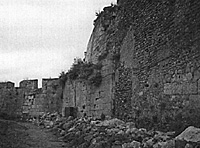 At right, looking up at the walls from the ditch in the area of the Lesser Breach.
At right, looking up at the walls from the ditch in the area of the Lesser Breach.
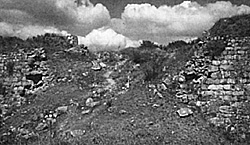
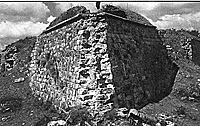 At left and right, breaches in Fort Conception, in Portugal, to give an idea of what a breach in a fortress looks like.
At left and right, breaches in Fort Conception, in Portugal, to give an idea of what a breach in a fortress looks like.
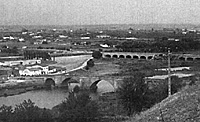 At right, bridge across the Agueda river is the one stormed by O'Toole, the Portuguese Cacadores, and the light company of the 83rd Regiment.
At right, bridge across the Agueda river is the one stormed by O'Toole, the Portuguese Cacadores, and the light company of the 83rd Regiment.
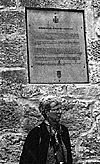 At right, Jane Hoyle stands beneath memorial to her great grat grandfather, Major Gen. Robert Crauford, commander of the Light Division. Crauford was mortally wounded in the assault. The memorial is set in the repaired section of the wall in which he is buried.
At right, Jane Hoyle stands beneath memorial to her great grat grandfather, Major Gen. Robert Crauford, commander of the Light Division. Crauford was mortally wounded in the assault. The memorial is set in the repaired section of the wall in which he is buried.
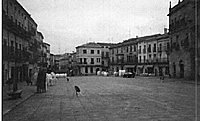 At right and below: main square of Ciudad Rodrigo in front of the town hall.
At right and below: main square of Ciudad Rodrigo in front of the town hall.
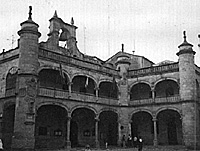 Finally, it was there that we put the only piece of cannon which could block the breach that had already been made. The walls of the old tower received a heavy pounding and crumbled like an avalanche, forming a second breach. This appeared to give us a bit of time, but the enemy's cheminements - still 100 toises away - had, by the end of the day, become a cause for anxiety and accelerated the loss of the city.
Finally, it was there that we put the only piece of cannon which could block the breach that had already been made. The walls of the old tower received a heavy pounding and crumbled like an avalanche, forming a second breach. This appeared to give us a bit of time, but the enemy's cheminements - still 100 toises away - had, by the end of the day, become a cause for anxiety and accelerated the loss of the city.